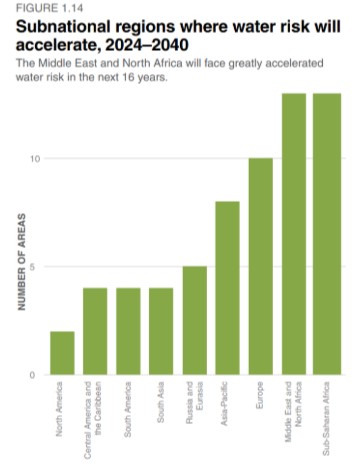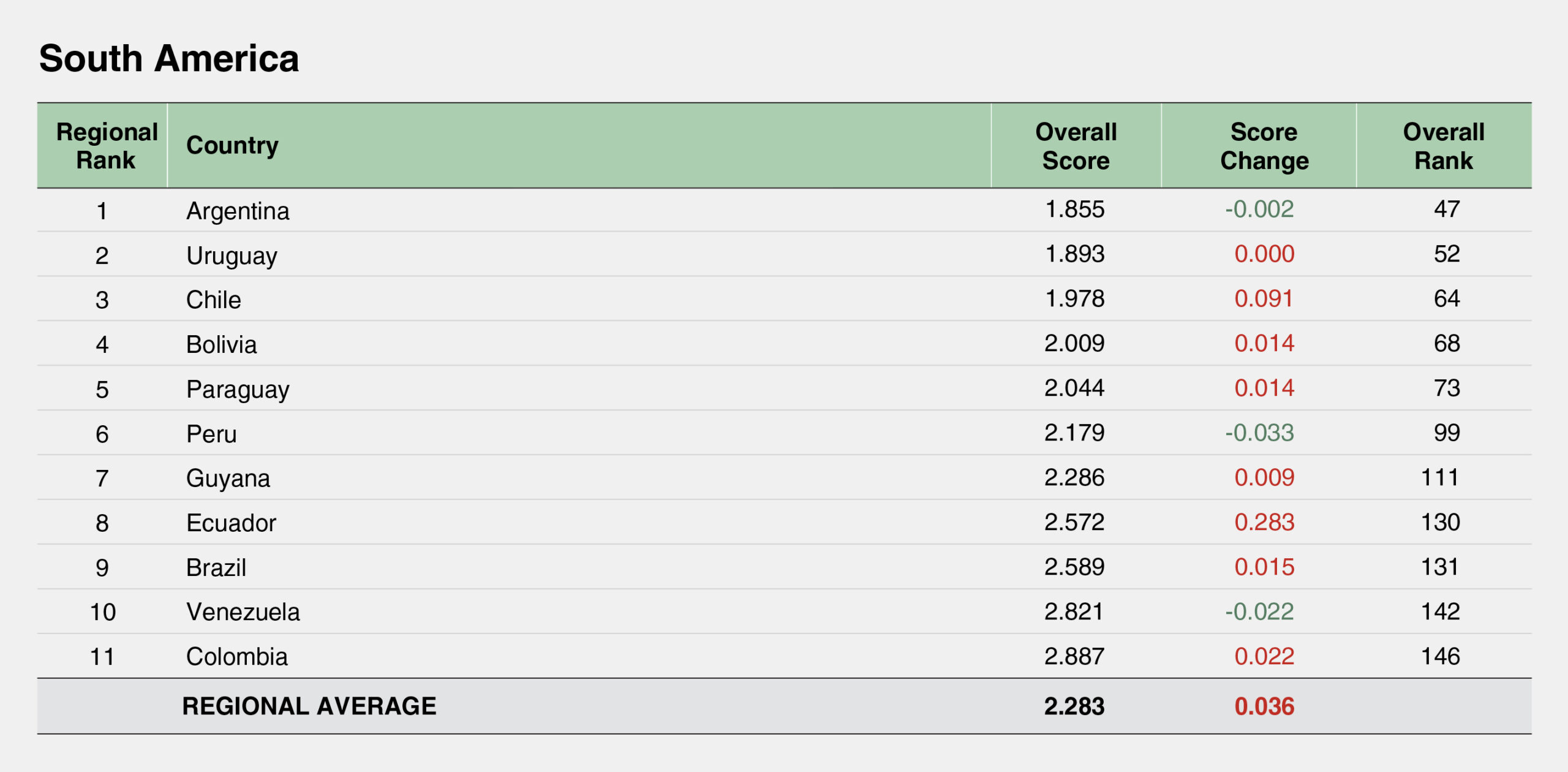Peacefulness in Central America and the Caribbean deteriorated slightly in the 2024 GPI, with an average deterioration in score of 0.17 per cent. Of the 12 countries in the region, five improved and seven deteriorated compared to the previous year. The overall fall in peacefulness was largely driven by large deteriorations in external conflicts fought and internal conflicts fought, as well as in the Political Terror Scale, as several countries in the region grappled with the ongoing impact of high levels of organised crime and civil unrest. However, there were some notable improvements, with El Salvador and Nicaragua recording the first and third highest improvements in peacefulness globally.

Despite experiencing a slight deterioration in score, Costa Rica remains the most peaceful country in the region, while ranked 58th overall in the 2024 GPI. The largest deteriorations occurred in the number of violent demonstrations, levels of violent crime, and homicide rate. Costa Rica suffered a surge of violent crime in 2023, with the homicide rate rising by more than 35 per cent as a result of shifts in drug-trafficking patterns throughout the country. Political in-fighting has delayed the implementation of policies aimed at addressing organised crime, despite government agreement on the urgency of the matter. Despite these issues, the government has been successful in boosting economic growth, demonstrating an improvement in the country’s political stability on a broader level.
Haiti recorded the largest deterioration in peacefulness in the region, and the fifth largest deterioration globally. The country experienced deteriorations in all three domains, driven by significant increases in violent crime, violent demonstrations, and the homicide rate. The country has been in a state of political instability since 2021, when the previous president Jovenel Moïse was assassinated. Rising gang violence in 2023 has continued to escalate, with over over half of the country and over 90 per cent of the capital city Port-au-Prince estimated to be controlled by violent criminal groups.
El Salvador recorded the largest improvement in peacefulness in the region, driven by a widespread crackdown on organised crime. The country’s largest improvements occurred in the number of deaths from internal conflict, violent demonstrations, homicide rate, and violent crime indicators. The government arrested and detained over 60,000 gang members and suspected gang members, leading to one of the largest ever recorded reductions in homicide rate. Perceptions of criminality also improved following these measures, with just 11 per cent of people reporting that they felt unsafe compared to 70 per cent in 2017. Although these actions increased stability and reduced violence in the short term, they have been controversial. El Salvador now has the highest incarceration rate in the world, with over one per cent of the population being incarcerated as of early 2024.
North America recorded the largest regional deterioration in the 2024 GPI, with the average level of peacefulness dropping by just under five per cent. However, despite this deterioration it remains the third most peaceful region globally, behind Europe and the Asia-Pacific. There is a considerable disparity in peacefulness between the two countries in the region, with Canada ranked as the 11th most peaceful country, while the US ranked as the 132nd most peaceful country globally. The largest regional deteriorations occurred in the Ongoing Conflict domain, with worsening perceptions of criminality, violent crime, and deaths from internal conflict.

The United States recorded the largest fall in peacefulness in the region, with its overall score deteriorating by 5.7 per cent. The primary driver of the deterioration was an increase in the number of politically motivated attacks and mass shootings, which resulted in 22 deaths in 2023, with associated deteriorations in the deaths from internal conflict and terrorism impact indicators. Despite an improvement in the country’s homicide rate over the past year, it still remains twice as high as the global average.
Peacefulness deteriorated in Canada for the first time since 2020, reflected across all three GPI domains. Canada is now ranked outside of the ten most peaceful countries in the world. The violent crime indicator had the most significant deterioration in the past year, with many provinces in Canada now experiencing gang-related violence. The homicide rate has deteriorated every year for the past four years and is now at a 30 year high. However, despite these deteriorations Canada remains one of the more peaceful countries in the world, with some of the highest levels of peacefulness in both the Militarisation and Ongoing Conflict domains.
South America experienced the second largest fall in peacefulness on the 2024 GPI, with the average level of peacefulness deteriorating by 3.6 per cent. South America is now the fifth most peaceful region globally. Seven of the 11 countries in the region recorded deteriorations, with three recording improvements, and one no change. Argentina is the only South American country that is ranked amongst the 50 most peaceful countries in the world. The fall in peacefulness in the region was driven by deteriorations on the Safety and Security and Ongoing Conflict domains, with the largest changes occurring on the homicide rate, Political Terror Scale, and intensity of internal conflict indicators.

Argentina remains the most peaceful country in South America, with a slight improvement in peacefulness over the past year, increasing its overall score by 0.2 per cent. The peaceful transfer of power after Javier Milei’s election as president in October 2023 improved the political instability indicator, despite pre-election concerns. Additionally, Argentina saw a decrease in its homicide rate and a lower terrorism impact, although perceptions of criminality worsened.
Colombia remains the least peaceful country in South America for the fourth consecutive year. While the Militarisation domain improved, the Ongoing Conflict domain significantly deteriorated, resulting in an overall decline in peacefulness by 2.2%. Increased attacks by splinter militias, mainly ex-FARC members, led to greater impact from terrorism and deaths from internal conflict. Colombia was the only South American country to record a death from terrorism in 2023. Clashes between the government and dissident rebel groups have hindered the full implementation of the 2016 peace agreement. Colombia recorded 781 deaths from internal conflict in 2023.
Peru saw the largest improvement in peacefulness in the region and is now ranked among the 100 most peaceful countries for the first time since 2020. In 2024, Peru improved on eight indicators, deteriorated on three, and showed no change in ten. The most significant improvements were in the Militarisation domain, particularly in UN peacekeeping funding, nuclear and heavy weapons, and weapons imports indicators.
Ecuador experienced the largest regional deterioration, and the second largest global deterioration in peacefulness, with a 12.36 per cent fall in score.This decline is primarily due to increased drug-related and gang-related violence. Perceptions of criminality have risen dramatically, with over 70 per cent of Ecuadorians reporting that they do not feel safe in their own cities or neighbourhoods at night. Latest estimates suggest that the country’s homicide rate may be as high as 45 per 100,000 people In response to the surge in violence, the new President Daniel Noboa declared a state of emergency, officially classifying 22 gangs as terrorist organisations.